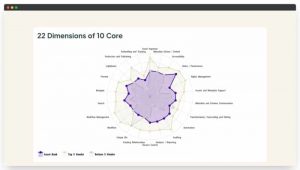The past two years has brought enormous challenges and changes — new ways of working, distance from coworkers, and opportunities to find new ways to drive success. None of us were prepared for this watershed experience and HR leaders have been on the frontline of this tsunami of change. Today, as the flood waters recede, what fresh treasures will we find left behind?
You have likely seen belonging at work become increasingly a topic of conversation for HR and business leaders. ‘Belonging’ ranked at the top of the Deloitte 2020 Global Human Capital Trends survey, with 79% of organizations considering it important for their success. There is a significant amount of academic research into belonging, showing that employees who feel a sense of belonging at work have higher overall work engagement. More specifically, these employees are more likely to experience greater job satisfaction, better mental health, higher levels of productivity, and lower levels of both.
At the Achievers Workforce Institute, we strive to advance academic knowledge and understanding with our in-depth and robust research reports. To that end, we built on secondary research to develop a belonging model and tested that model with a survey to more than 3,500 employees around the world.
That research forms the foundation of the Achievers Workforce Institute 2021 Culture Report on Belonging at Work.
The business case for belonging at work
Belonging is a key driver of individual and organizational success. People with a strong sense of belonging are twice as likely to be engaged — and they’re also twice as likely to be productive, resilient, satisfied, and committed.
Our research confirmed our hypothesis that belonging is a key factor to foster inside your organization because when people feel a strong sense of belonging, they are also far more likely to be happy, healthy, and productive employees at work.
On the other hand, people with a low sense of belonging are only a quarter as likely to say that they’re engaged and they express much lower levels of commitment, enthusiasm, productivity, and resilience.
We know that there are many employees in the workplace today that are truly struggling and we believe that by building and fostering an experience of belonging we have the opportunity to help them become thriving, productive, happy team members once again.
Building a culture of belonging
But it wasn’t enough for us to say “this matters”. We also needed to answer the question “how do we get there?”
That’s where the five pillars of belonging come in. When your employees feel welcomed, known, included, supported, and connected, then you can be confident they feel a strong sense of belonging at your organization. Many of the HR tools and programs you already have in place are supporting one or more of these pillars. In fact, these pillars offer a clear framework for assessing HR technology and training by ensuring it aligns with at least one pillar.
Activating the five pillars of belonging at work
How can you activate each pillar to ensure your employees feel that strong sense of belonging at work that will enable positive business outcomes?
Welcomed
“Introduced to, and incorporated within, the organizational culture and community”
- Consistently implement thoughtful, structured organizational onboarding
- Provide introduction to unique organizational culture
- Invite to culture and team building events and activities
Recognition action: Send a personalized recognition to new employees or team members on their first day of work.
Known
“Understood, motivated, and celebrated as an individual”
- Use and integrate culture, values, or personality testing
- Customize style of meetings, coaching etc. to support unique wiring
- Encourage social events to create personal connections, both in person and online
Recognition action: Regularly recognize employees in alignment with their own personal values and interests.
Included
“Valued and accepted without reservation”
- Regularly gather employee feedback and share results at the team level
- Encourage a wide variety of social clubs or events and ensure everyone is invited
- Introduce and support Employee Resource Groups (ERGs) to serve all employees
Recognition action: Recognize behaviors that promote a diversity of input and perspective.
Supported
“Consistently and meaningfully nurtured and developed”
- Encourage regular, meaningful manager contact
- Empower managers to provide coaching to meet specific employee needs
- Ensure employees have the development and resources they need to succeed in their role
Recognition action: Recognize employees for working toward growth and development goals.
Connected
“Developing and maintaining relationships across a diverse population”
- Prioritize the development of a diverse employee body
- Facilitate cross-functional relationship building
- Utilize connection tools to break down silos across function, location, and level
Recognition action: Recognize actions that bring people together across business and demographic lines.
Learn more about belonging at work
Belonging is the next frontier for HR and business leaders. If you can foster a strong sense of belonging at work you will see engagement, productivity, and turnover improve.
Business leaders have the challenge and opportunity right now to invest in their employees’ sense of belonging, to not only drive business results but to have happier, healthier employees as well. This research is intended to guide you on your journey, leveraging DEI and the pillars of belonging, to a brighter future for all your employees and your organization.
Learn more about belonging at work by downloading the 2021 Culture Report on Belonging at Work today.
And for more insights into the actions you can take for each pillar of belonging, be sure to join Dr Natalie Baumgartner for her ACE session on September 23, CHRO Call to Action: Creating a Culture of Belonging. Register for ACE for free today.
Business & Finance Articles on Business 2 Community
(89)



